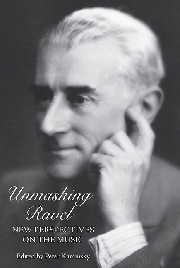Book contents
- Frontmatter
- Dedication
- Contents
- Acknowledgments
- Introduction
- Part One Orientations and Influences
- Part Two Analytical Case Studies
- 4 Ravel's Approach to Formal Process: Comparisons and Contexts
- 5 Repetition as Musical Motion in Ravel's Piano Writing
- 6 Playing with Models: Sonata Form in Ravel's String Quartet and Piano Trio
- 7 Spiral and Self-Destruction in Ravel's La valse
- 8 Diatonic Expansion and Chromatic Compression in Maurice Ravel's Sonate pour violon et violoncelle
- Part Three Interdisciplinary Perspectives
- List of Contributors
- Index
5 - Repetition as Musical Motion in Ravel's Piano Writing
from Part Two - Analytical Case Studies
Published online by Cambridge University Press: 05 September 2013
- Frontmatter
- Dedication
- Contents
- Acknowledgments
- Introduction
- Part One Orientations and Influences
- Part Two Analytical Case Studies
- 4 Ravel's Approach to Formal Process: Comparisons and Contexts
- 5 Repetition as Musical Motion in Ravel's Piano Writing
- 6 Playing with Models: Sonata Form in Ravel's String Quartet and Piano Trio
- 7 Spiral and Self-Destruction in Ravel's La valse
- 8 Diatonic Expansion and Chromatic Compression in Maurice Ravel's Sonate pour violon et violoncelle
- Part Three Interdisciplinary Perspectives
- List of Contributors
- Index
Summary
Ravel use des formes classiques, comme le jongleur des balles, des plumes, des éventails, des mille objets qui volent entre ses doigts.
[Ravel uses classical forms as the juggler uses balls, feathers, fans, the thousand objects that fly between his fingers.]
André SuarèsIn Ravel's writing for the piano, the tactile dimension influences and sometimes determines aspects of musical structure. We consider physical motions—the gestures of the performer—as a dimension of musical structure in Ravel's piano-centered writing, and demonstrate how the conjunction of physical and musical features produces distinctive units, which, repeated and varied, create characteristic qualities of musical motion.
Consider the opening of Jeux d'eau (ex. 5.1), with its ascending right-hand arpeggiation <D#–G#–D#–F#> requiring the fingering <1, 2, 4, 5>—a figure that is inspired in part by the way the hand lies on the keyboard. This figure, set in motion by the rolling of the hand over the black keys, is immediately extended by retrograde (the return down the opening arpeggio), and then by a neighboring figure in halved note values (down a step in thirty-second notes, retaining the G# as the second-finger pivot). The initial four-note figure and its transformations combine to form ever-larger units, eventually creating, in this example, half-measure, then (by literal repetition) one-measure units, the third measure roughly sequencing the first up a fourth.
- Type
- Chapter
- Information
- Unmasking RavelNew Perspectives on the Music, pp. 111 - 142Publisher: Boydell & BrewerPrint publication year: 2011



